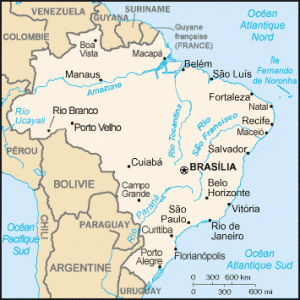Brazil January 4, 2023 Amazon , Amazon forest , Amazon River , Amazone , Americas , Atlantic , Atlantic Ocean , Bahia , Belem , Belo Horizonte , Brasil , Brasilia , Brazil , Community of Portuguese-speaking countries , Curitiba , El Salvador , Federative Republic of Brazil , forest , Fortaleza , Goiânia , jungle , Latin America , Lusophony , Manaus , Maranhão , Mato Grosso , Minas Gerais , Natal , Paraná , Porto Alegre , Portuguese , Portuguese colony , Portuguese language , Recife , Rio de Janeiro , Rio Grande , Rio Grande do Norte , Rio Grande do Sul , Salvador , São Luis , Sao Paulo , South America , South Atlantic Ocean , UNASUR Official name Federative Republic of Brazil Name in local language República Federativa do Brasil (pt) Continent Americas Subcontinent South America Population (ranking: 7e ) 207,750,291 inhabitants (2023) Population growth 0.73 % / year Area 8,510,346 km² Density 24.41 inhabitants / km² GDP (ranking: 10e )1,839.758 billions $USD (2019) GDP/capita (ranking ) 8,717 $USD (2019) GDP growth 1.10 % / year (2019) Life expectancy (ranking ) 76.97 years (2021) Birth rate 13.79 ‰ (2021) Fertility rate 1.76 children / woman (2021) Death rate (ranking ) 6.61 ‰ (2021) Infant mortality rate (ranking ) 11.20 ‰ (2021) Literacy rate 93.40 % (2019) Official languages Portuguese Currency Real (R$ BRL) HDI (ranking: 119e )0.754 / 1 (2021) EPI (ranking )60.70 (2018) Government Federal presidential constitutional republic Head of State President Luiz Inácio Lula da Silva National Day 7 September (independence of 1822) ISO Codes BR, BRA Demonym Brazilian Tourists (ranking ) 6,621,000 people (2018)
Brazil is a federal state of South America. It is the largest country in the subcontinent, with almost half of its total area, and the fifth largest country in the world. It’s also one of the most populated countries of the world.Guyana , Suriname , French Guiana , Venezuela and Colombia to the north, Peru , Bolivia and Paraguay to the west, Argentina and Uruguay to the south. It doesn’t have borders with Chile and Ecuador .largest urban areas in the world with more than 36 million inhabitants.
Rio de Janeiro. Photo: Jens Hausherr Amazon River, Brazil Urban areas (2018) Urban areas Population São Paulo 36,315,721 inhabitants Rio de Janeiro 12,699,743 inhabitants Belo Horizonte 5,916,189 inhabitants Brasília 4,560,505 inhabitants Porto Alegre 4,317,508 inhabitants Fortaleza 4,074,730 inhabitants Recife 4,054,866 inhabitants Salvador 3,899,533 inhabitants Curitiba 3,615,027 inhabitants Manaus 2,631,239 inhabitants Goiânia 2,518,775 inhabitants Belém 2,491,052 inhabitants Vitória 1,951,673 inhabitants São Luis 1,621,102 inhabitants Natal 1,587,055 inhabitants Joinville 1,400,128 inhabitants Maceió 1,330,291 inhabitants João Pessoa 1,266,463 inhabitants Teresina 1,222,940 inhabitants Florianópolis 1,189,947 inhabitants Londrina 1,101,595 inhabitants Campo Grande 1,069,420 inhabitants Aracaju 1,052,464 inhabitants Cuiabá 864,131 inhabitants
Administrative divisions States Population Area Acre 829,780 inhabitants 164,173 km² Alagoas 3,125,254 inhabitants 27,831 km² Amapá 774,268 inhabitants 142,471 km² Amazonas 3,952,262 inhabitants 1,559,168 km² Bahia 14,659,023 inhabitants 564,760 km² Ceará 8,936,431 inhabitants 148,894 km² Espírito Santo 3,975,100 inhabitants 46,074 km² Federal District 2,923,369 inhabitants 5,761 km² Goiás 6,950,976 inhabitants 340,243 km² Maranhão 6,800,605 inhabitants 329,651 km² Mato Grosso 3,784,239 inhabitants 903,207 km² Mato Grosso do Sul 2,833,742 inhabitants 357,148 km² Minas Gerais 20,732,660 inhabitants 586,514 km² Pará 8,442,962 inhabitants 1,245,871 km² Paraíba 4,030,961 inhabitants 56,467 km² Paraná 11,835,379 inhabitants 199,299 km² Pernambuco 9,051,113 inhabitants 98,068 km² Piauí 3,270,174 inhabitants 251,755 km² Rio de Janeiro 16,615,526 inhabitants 43,750 km² Rio Grande do Norte 3,303,953 inhabitants 52,810 km² Rio Grande do Sul 11,088,065 inhabitants 281,707 km² Rondônia 1,616,379 inhabitants 237,765 km² Roraima 634,805 inhabitants 223,645 km² Santa Catarina 7,762,154 inhabitants 95,731 km² São Paulo 46,024,937 inhabitants 248,219 km²
See also 



